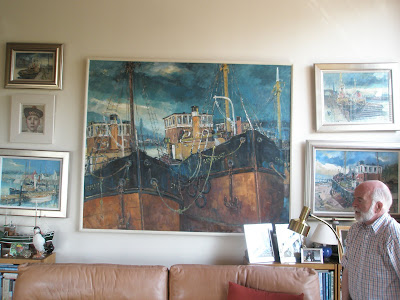
In the living room of his Ayrshire home – with its panoramic view over the estuary to Cumbrae – James Watt sits surrounded by some of the paintings which have established him as Scotland’s finest maritime artist.
For decades he has captured the hubbub of life along the Clyde. Admirers of his russet-coloured harbours and dark tugs and trawlers compare him to the French Impressionists; the Queen collects his work; and tomorrow, the Royal Glasgow Institute will celebrate his career.
But recognition has not always come so easily. Setting out to paint in the austerity of the 1950s, Watt simply could not sell, and he vividly recalls how in a fit of anguish he destroyed some of his finest early works. He had, he says, made an appointment at a famous shipyard, confident of persuading its owner to invest. As he prepared to meet his new patron, Watt laid his pictures proudly round the walls of the boardroom.
“This man walked slowly round them. Then he called me to the window looking over the yard and said, ‘I’ve been staring at this every day of my working life. The last thing I want is to take any of it home with me.’ He didn’t buy a thing. I took all the paintings home and burnt them. I regret that now,” says Watt evenly.
Only two paintings in his living-room gallery are not his own, a white flower, gifted to Nancy, his wife, and a self-portrait of a woman in a soldier’s bonnet. Both unmistakeably are in the hand of his daughter Alison, whose exhibition, Phantom, has just opened at the National Gallery in London.
Their work seems light years apart – Alison’s stylised paintings are often full of eroticism – but the very difference in their outlook is a matter of pride to her father. For 38 years Watt was art master at St Columba’s High in Greenock, and though all four of his children attended the school, he made sure he taught none of them.
“There is nothing I hate more in the art world than children rehashing their mother’s or father’s paintings,” he says. “I know some artists and I feel like saying to them, ‘You should be ashamed of yourself.’ It’s a bit sad, a father virtually imposing his personality on his children. All I did when was encourage them, no more than that. But Alison used to win competitions and people would say, ‘O, your dad did that for you’. Well, I didn’t.”
Watt was born in Port Glasgow and spent his own artistic education by the Clyde. His father, “an old school socialist” was a riveter, his grandfather too, and every man he knew worked in the yards. Poverty rooted families to the town for generations, yet everyone spoke the exotic language of the sea. His “total immersion” in this hard but strangely beautiful world gave Watt a canvas for life.
“The men, the women, the children, everyone used nautical terms,” he says. “Just as city children become streetwise, as river children, we were riverwise. We built rafts, we repaired old boats and sailed them. Everything we did prepared us to be shipbuilders.”
In the 1940s, this cocoon was punctured briefly by the arrival of Stanley Spencer, despatched by the government to work as a war artist in the town. Watt remembers Spencer sketching his Port Glasgow Resurrection series from hill above the cemetery and the way “he wheeled around his canvas and easel in an old pram”. Spencer “dressed weirdly, everyone’s idea of what an artist should be – something beyond our ken.” Watt never thought for a moment that he could be such a man.
It was an equally eccentric figure who finally connected him to his life’s work. Joe Kelly, a one-legged ex-miner from Lochgelly, arrived at his school to teach art when the boy was 15. Kelly was an enthusiast whose inspiration fired up Watt’s natural talent and sent him on his way through Glasgow School of Art.
 Watt’s later encounter with the shipyard owner did not prove terminal. In his 20s and 30s, the painter toured Greenock’s harbours looking for inspiration and found it in the Lady Bute, a puffer tied to the wall. “It was an inspirational thing. I could stand 20 feet from it and yet see the entire puffer. It came to symbolise the whole of the Clyde.”
Watt’s later encounter with the shipyard owner did not prove terminal. In his 20s and 30s, the painter toured Greenock’s harbours looking for inspiration and found it in the Lady Bute, a puffer tied to the wall. “It was an inspirational thing. I could stand 20 feet from it and yet see the entire puffer. It came to symbolise the whole of the Clyde.” He spent summers on the little boats, watching the hard lives of their drink-addled crews unfold in front of him, painting the puffers and the ports they visited, and arriving on Islay or Harris, to be introduced as “Oor artist, Jum.” Not that he needed any ntroduction. Watt remembers the harbour master at Port Ellen telling a skipper, “Wullie, your Jum’s got more paint on his jumper than you’ve got on your puffer.”
These days, the puffers, like the yards have gone, and there’s “not so much as a rowing boat” in Greenock harbour – a decline recorded by Watt in thousands of paintings over five decades. That shipyard owner who so casually dismissed the struggling young artist might wish he’d kept just one picture as a keepsake.
No comments:
Post a Comment